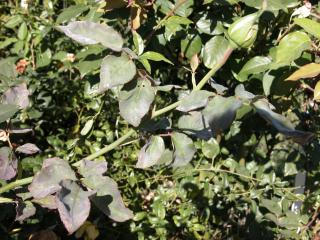Fungal problems
Black spot
Black spot, one of the most common diseases of roses, is caused by the fungus Diplocarpon rosae.
Infection results in irregular black spots with fringed margins developing on leaves and young stems. Affected leaves turn yellow and drop prematurely and if defoliation is severe stem dieback can occur. Spores are spread by wind and water-splash.
To control black spot remove and destroy all diseased material. When new growth occurs spray bushes with mancozeb, myclobutanil or triforine. Organic controls include sprays containing bicarbonate of soda (potassium bicarbonate).
Powdery mildew
The fungus Sphaerotheca pannosa causes the disease powdery mildew on roses. New growth is most susceptible. Leaves, stems, and flower buds develop a pale grey powdery coating, leaf edges may scorch and curl inwards, and buds may be deformed. The fungus can overwinter in infected buds. The disease spreads by wind-borne spores.
To control powdery mildew, remove and destroy diseased material. During the growing season spray bushes with mancozeb, lime sulphur, tebuconazole, myclobutanil or triforine. Organic sprays contain bicarbonate of soda (potassium bicarbonate). Make your own spray by mixing one part full cream milk with ten parts water and spray at the first sign of the disease.
Botrytis
The fungus Botrytis cinerea affects most above ground plant parts. Flowers often become spotted or may fail to open, eventually becoming covered in a grey or brown mould. Purple lesions occurring on canes are often caused by botrytis. Spores are wind-borne and also can be spread on garden tools like secateurs.
To treat botrytis remove and destroy diseased material. Spray bushes in late summer and autumn with mancozeb. When pruning, disinfect secateurs in bleach before progressing to the next bush, and apply fungicide immediately to protect wounds from infection.
Downy mildew
The fungus Peronospora sparsa causes downy mildew. Purplish-red or dark brown, irregular, and often angular, blotches develop on leaf surfaces, and during humid weather a blue-grey, downy growth of fungus may appear on the undersides.
The leaves droop, turn yellow, and may drop. Stems and calyces develop purple or blackish spots, streaks, or blotches. Petals have brown, dead areas. Infected buds may produce deformed flowers. Spores are wind-borne but need free water on the leaf surface to germinate.
To control downy mildew remove and destroy diseased material and spray bushes with a copper fungicide.


